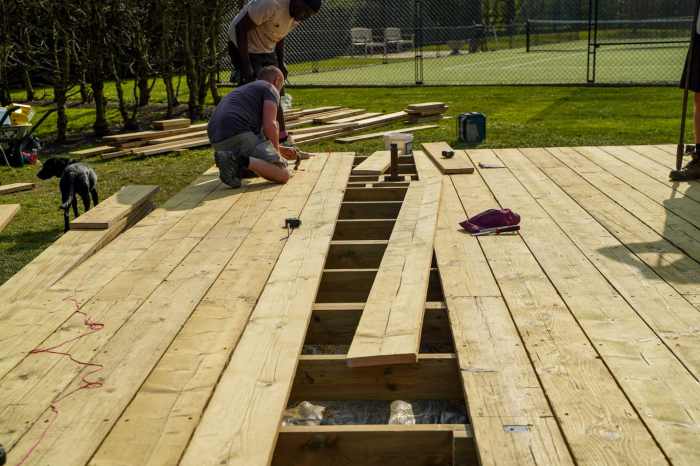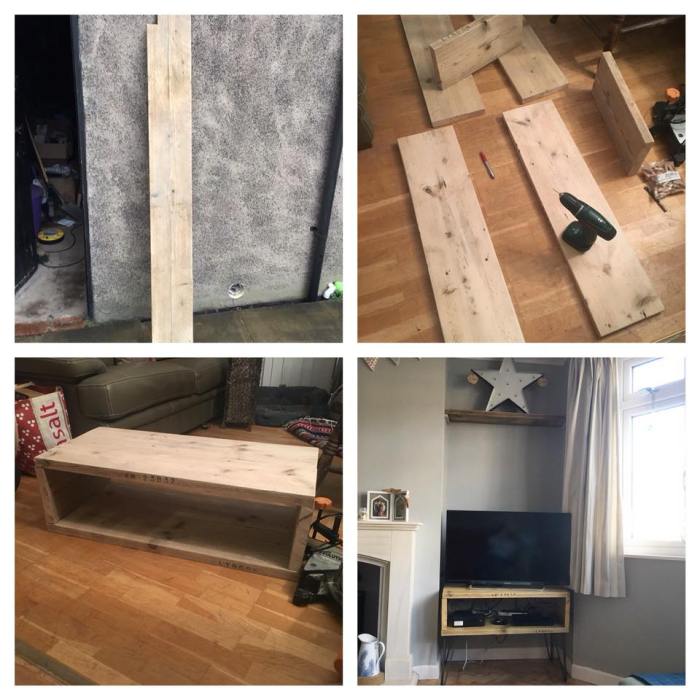Prepare to be inspired as we dive into the world of scaffold board ideas! These versatile and robust planks offer a treasure trove of possibilities for DIY enthusiasts and interior design lovers alike. Join us on an adventure where functionality meets aesthetics, and your imagination knows no bounds.
From chic shelves to rustic tables, scaffold boards can transform your living space into a haven of style and practicality. Let’s uncover the secrets of these humble planks and unlock your creativity!
Scaffold Board Styles
Scaffold boards are available in a range of styles to suit different applications. The most common styles include:
- Standard scaffold boards:These are the most basic type of scaffold board, made from untreated timber and typically used for temporary scaffolding structures.
- Treated scaffold boards:These boards have been treated with a preservative to protect them from rot and decay, making them suitable for use in outdoor applications.
- Laminated scaffold boards:These boards are made from multiple layers of timber glued together, which makes them stronger and more durable than standard scaffold boards.
- Aluminum scaffold boards:These boards are made from lightweight aluminum, which makes them easy to handle and transport.
The choice of scaffold board style will depend on the specific application. Standard scaffold boards are the most economical option, but they are not as durable as treated or laminated boards. Treated boards are a good choice for outdoor applications, while laminated boards are the strongest and most durable option.
Aluminum boards are lightweight and easy to handle, but they are more expensive than other types of scaffold boards.
Scaffold Board Materials

Scaffold boards are typically made from timber, but other materials such as aluminum and composite materials are also used.
Timber scaffold boards are the most common type and are typically made from softwood species such as spruce, pine, or fir. These boards are lightweight, strong, and relatively inexpensive. However, they are susceptible to rot and decay if not properly treated.
Aluminum scaffold boards are more durable than timber boards and are not susceptible to rot or decay. They are also lightweight and easy to handle. However, they are more expensive than timber boards.
Composite scaffold boards are made from a combination of materials, such as wood and plastic. These boards are lightweight, strong, and durable. They are also resistant to rot and decay. However, they are more expensive than both timber and aluminum boards.
Advantages and Disadvantages of Different Scaffold Board Materials
- Timber:Lightweight, strong, inexpensive, but susceptible to rot and decay.
- Aluminum:Durable, not susceptible to rot or decay, lightweight, easy to handle, but more expensive than timber.
- Composite:Lightweight, strong, durable, resistant to rot and decay, but more expensive than both timber and aluminum.
Scaffold Board Sizes

Scaffold boards come in a variety of sizes to suit different applications. The most common sizes are listed in the table below.
When choosing the right size for your project, it is important to consider the following factors:
- The span of the scaffold
- The load that will be placed on the scaffold
- The height of the scaffold
Standard Scaffold Board Sizes
| Width (mm) | Thickness (mm) | Length (m) |
|---|---|---|
| 225 | 38 | 3.6 |
| 225 | 38 | 4.2 |
| 225 | 38 | 4.8 |
| 225 | 38 | 5.4 |
| 225 | 38 | 6.0 |
Scaffold Board Installation

Installing scaffold boards is a crucial step in ensuring a safe and stable work platform. Here’s a step-by-step guide to help you with the process:
Materials and Tools
- Scaffold boards
- Scaffold brackets or couplers
- Spanners or wrenches
- Level
- Spirit level
- Safety harness
Steps
- Position the scaffold brackets:Determine the spacing of the brackets based on the length of the scaffold boards and the desired load capacity. Secure the brackets to the scaffold uprights using bolts or pins.
- Place the scaffold boards:Carefully lift the scaffold boards and place them on the brackets. Ensure they are properly seated and level.
- Secure the boards:Use the couplers to tighten the scaffold boards to the brackets. Check that the boards are securely fastened and cannot move.
- Level the platform:Use a level or spirit level to check if the scaffold platform is level. Adjust the brackets or couplers as necessary to ensure stability.
- Inspect the installation:Before using the scaffold platform, inspect all the connections and components to ensure they are secure and in good condition.
Tips for Safety, Scaffold board ideas
- Always wear a safety harness when working on scaffolds.
- Use a scaffold with a guardrail or toe board to prevent falls.
- Never overload the scaffold platform.
- Inspect the scaffold regularly for any damage or defects.
- Follow all safety regulations and guidelines for scaffold installation and use.
Scaffold Board Safety
Ensuring safety is crucial when using scaffold boards. Implement strict safety measures to prevent accidents and ensure a secure work environment.
Regular inspections and maintenance are vital to identify any potential hazards. Inspect boards for cracks, splinters, or any other signs of damage. Ensure proper storage and handling to prevent warping or damage.
Inspection and Maintenance
- Inspect boards before each use for any visible damage.
- Check for cracks, splinters, or any other signs of wear and tear.
- Replace damaged boards immediately to prevent accidents.
- Store boards in a dry and well-ventilated area to prevent warping.
- Handle boards carefully to avoid damage during transportation or storage.
Scaffold Board Accessories
To enhance the safety, functionality, and versatility of scaffold boards, various accessories are available. These accessories can facilitate installation, improve safety measures, and extend the applications of scaffold boards.
Let’s explore the commonly used accessories and their respective purposes:
Clamps and Brackets
- Pipe Clamps:Secure scaffold boards to pipes or other cylindrical objects, providing a stable and adjustable connection.
- Flange Clamps:Connect scaffold boards to flanges or beams, creating a strong and secure hold.
- Brackets:Support scaffold boards by attaching them to walls or other structures, offering additional stability and load-bearing capacity.
Couplers and Connectors
- Couplers:Join two or more scaffold boards end-to-end, extending the length of the platform.
- Connectors:Connect scaffold boards at right angles or other angles, creating custom configurations for various applications.
Safety Accessories
- Anti-Slip Tape:Applied to the surface of scaffold boards to enhance traction and prevent slips, ensuring safety when working at heights.
- Toe Boards:Prevent objects or tools from falling off the edges of scaffold boards, reducing the risk of accidents.
- Guardrails:Provide a physical barrier around scaffold boards, protecting workers from falls.
Other Accessories
- Castors:Attach to the bottom of scaffold boards, enabling easy movement and repositioning of the platform.
- Plank Jacks:Adjust the height of scaffold boards, allowing for precise leveling and support.
- Storage Bags:Protect scaffold boards from damage and weather conditions during storage and transportation.
Scaffold Board Projects
Scaffold boards offer versatility and durability for various projects, from functional furniture to decorative accents. They can be used to create rustic tables, shelves, benches, and more.
DIY Scaffold Board Table
Materials:
- 4 scaffold boards (1200mm x 225mm)
- 4 hairpin legs (280mm)
- Screws
- Drill
Steps:
- Sand the scaffold boards to remove splinters and create a smooth surface.
- Measure and mark the placement of the legs on the underside of the boards.
- Drill pilot holes and secure the legs with screws.
- Flip the table and enjoy your new industrial-chic masterpiece!
Scaffold Board Design: Scaffold Board Ideas
Designing a scaffold board project requires careful consideration of the project’s purpose, aesthetic appeal, and structural integrity. Factors such as the intended use, available space, and desired ambiance should be taken into account.
Choosing a Design
When selecting a design, consider the following factors:
- Purpose:Determine the primary function of the scaffold board project, whether it’s for seating, storage, or decoration.
- Space constraints:Measure the available space and plan the project’s dimensions accordingly.
- Ambiance:Choose a design that complements the existing décor or creates the desired atmosphere.
- Structural integrity:Ensure the design is sturdy enough to withstand the intended use and weight.
- Customization:Consider incorporating unique elements or finishes to personalize the project.
Scaffold Board Maintenance
Maintaining scaffold boards is crucial for ensuring their safety and longevity. Regular cleaning, inspection, and treatment can significantly extend their lifespan.
Cleaning
Regularly remove dirt, debris, and paint spills from scaffold boards. Use a stiff brush or a pressure washer to loosen dirt and grime. For stubborn stains, use a mild detergent or a specialized cleaning solution.
Inspection
Thoroughly inspect scaffold boards before each use. Look for cracks, splinters, rot, or any other damage. If you find any defects, remove the board from service and replace it with a new one.
Treatment
To extend the lifespan of scaffold boards, apply a protective treatment such as paint, varnish, or a water-repellent sealant. These treatments will protect the wood from moisture, UV rays, and other environmental factors that can cause deterioration.
Scaffold Board Alternatives
Scaffold boards are a popular choice for various projects, but there are alternatives available that offer different advantages and disadvantages.
When considering alternatives, factors such as cost, durability, ease of installation, and aesthetics should be taken into account.
Recycled Plastic
Recycled plastic is a sustainable and durable alternative to scaffold boards. It is resistant to rot, moisture, and pests, making it suitable for outdoor use.
Recycled plastic boards are also lightweight and easy to install, but they can be more expensive than traditional scaffold boards.
Composite Decking
Composite decking is a mixture of wood fibers and plastic, offering a combination of strength and durability. It is resistant to fading, staining, and moisture, making it a low-maintenance option.
Composite decking is more expensive than scaffold boards, but it has a longer lifespan and requires less upkeep.
Aluminum Planks
Aluminum planks are lightweight and durable, making them easy to transport and install. They are also resistant to corrosion and fire, but they can be more expensive than scaffold boards.
Aluminum planks are a good choice for temporary structures or projects that require a high level of durability.
Last Word
As we bid farewell to our scaffold board adventure, remember that the possibilities are limitless. Embrace the versatility of these planks and let your imagination soar. Whether you’re crafting a cozy coffee table or a statement-making headboard, scaffold boards are your canvas to create spaces that are both functional and visually stunning.
So, go forth, experiment, and unleash your inner designer with these extraordinary scaffold board ideas!
FAQ Explained
What are the most popular scaffold board projects?
Scaffold boards excel in creating shelves, tables, headboards, and even outdoor furniture, offering endless opportunities for customization.
How do I choose the right size scaffold board for my project?
Consider the dimensions of your project and the desired weight capacity. Standard scaffold board sizes range from 2×6 inches to 2×12 inches.
What safety precautions should I take when using scaffold boards?
Always inspect boards for damage, wear protective gear, and ensure proper support and stability during installation.


